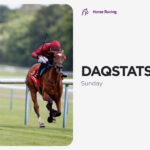Another Saturday, another big race with a big draw bias.
We have been here before. Draw biases are not what they once were. Gone are the days when you can put a line through every horse drawn higher than x or lower than y or between a and b (insert values according to specific race), but the draw is still a factor, just like ground and trainer form and current form and potential for progression and track and distance and rider and strength in the market and the rest are factors.
It is a frustrating factor, mind you, in that a draw bias can be negated or reversed or accentuated depending on how a race is run, which can render any work that you have done in assessing a draw advantage pretty much redundant. If there is a perceived advantage to be gained from racing on the stands rail in a straight-track race, for example, and the majority of the jockeys in a race recognise and seek to avail of that advantage, and consequently congregate towards the stands rail, then the actual advantage in that race may be to race in the centre of the track or on the far rail, thereby avoiding the traffic problems to which those who were perceived to have been drawn well will inevitably be subjected. If that makes sense.
Same with a race on a round track, in which an inside draw is perceived to be an advantage if you can gain a handy early position. In that situation, there is always a chance that the riders drawn low will seek to make full use of their inside draw, and kick on through the early stages of the race in order to try to secure said early handy position, thereby setting too fast an early pace and setting the race up for the closers – those who were drawn high and settled back in the field.
That said, the effect of the draw is at least worth investigating in any race in which there is a chance that it will make a difference. Take tomorrow’s Great St Wildfrid Handicap at Ripon. Last year, in a race run on good to soft ground, the first three horses home were drawn in stalls 17, 20 and 19 of 19 runners (there was one non-runner). That was significant, the first three places filled by three of the four horses who emerged from the four highest stalls, returned at odds of 11/1, 10/1 and 40/1 (this year’s July Cup winner Mayson, incidentally) respectively.
Strange one. The popular perception last year was that it would be a low-drawn horse’s race, as evidenced by the fact that the two joint-favourites for the race, Fathsta and Tajneed, racing from stalls two and three respectively.
In 2010, the first four horses home in the race, also run on good to soft ground, emerged from stalls six, one, eight and three respectively. However, in 2011 the race was run in a time that was 1.34secs slower than standard. In 2010, it was run in a time that was 2.31secs slower than standard, suggesting that the ground was significantly slower in 2010 than it was last year. That hypothesis is backed up by the Racing Post’s respective going estimates on the sprint track on the day: 0.40secs/furlong slower than standard in 2010, 0.25secs/furlong slower than standard in 2011.
Here’s a table I have done up for the race which may be of some use:
| Year | Winner draw | Second draw | Third draw | Fourth draw | No. of runners | Official going description | Time of race compared to standard | Racing Post’s time-based going estimate |
| 2011 | 17 | 20 | 19 | 6 | 19 | gs | -1.34secs | -0.25s/f |
| 2010 | 6 | 1 | 8 | 3 | 17 | gs | -2.31secs | -0.40s/f |
| 2009 | 11 | 19 | 4 | 13 | 17 | gf | +0.90secs | +0.26s/f |
| 2008 | 10 | 5 | 12 | 9 | 20 | gs | -2.75secs | -0.24s/f |
| 2007 | 2 | 4 | 15 | 3 | 22 | g | -0.61secs | +0.22s/f |
| 2006 | 12 | 17 | 16 | 18 | 19 | s | -2.82secs | -0.28s/f |
| 2005 | 1 | 4 | 2 | 7 | 23 | gs | -2.19secs | -0.20s/f |
| 2004 | 11 | 17 | 10 | 2 | 19 | s | -2.65secs | -0.30s/f |
| 2003 | 1 | 2 | 7 | 8 | 23 | g | +0.47secs | n/a |
| 2002 | 6 | 4 | 20 | 14 | 22 | g | +1.10secs | n/a |
Conclusions? Whatever about other races run over the course and distance, the draw may not be as important in the Great St Wilfrid, a big-field high-class handicap in which they race across the breadth of the track – or in the new consolation race run earlier on the day – on any ground as is generally believed. Going on the last two years only, it appears that you need to be drawn high or low on soft ground. But a middle draw doesn’t appear to have been a disadvantage in 2004, 2006 or 2008 when the ground was just as slow as, or slower than, it was last year.
On good or fast ground, as in 2002, 2003, 2007 and 2009, you could argue that, on balance, a low draw is probably a slight advantage, but only slight.
First thought is that this conclusion gives us no edge. However, the market seems to be favouring those horses drawn low – the top three horses in the market and six of the top nine are drawn low – so there may be an edge in siding with those drawn middle to high.
Of those, Our Jonathan and Johannes are the two who are most over-priced in my book. You can easily ignore Our Jonathan’s latest run at Chester, when he missed the break and was always on the back foot. Second in this race last year on his only visit to the track, he is a high class sprinter on his day, as he proved when he ran away with the Ayr Gold Cup last September.
He does have plenty of weight, but highweights have done well in this race in the past, and the handicapper has given him a decent chance by (a little surprisingly) dropping him 2lb for his Chester run, which leaves him on a mark of 108, 6lb lower than his peak. Kevin Ryan’s horses are in better form now than they were a few weeks ago, and it is probable that the trainer has had this race in mind for Our Jonathan for a while.
Johannes is nine years old now, but he put up one of the best performances of his life in winning a good handicap at Glorious Goodwood two weeks ago. He was well beaten in this race last year, and in 2010, but he won and finished second over this course and distance on his two previous runs at the track, and he has run really well in two of the three races in which useful 7lb-claimer George Chaloner has ridden him.
There shouldn’t be much between Richard Fahey’s horse and Goodwood runner-up Louis The Pious again, and Graham Lee’s mount could represent the best value among those drawn low.
.
Did you know that as well as checking the realtime prices on BETDAQ below – you can also log into your account and place your bets directly into BETDAQ from BETDAQ TIPS.







